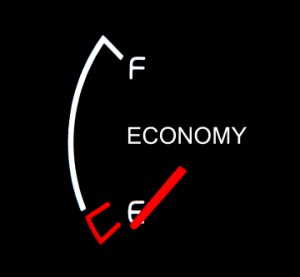Falling interest rates are usually met by borrowers with a toast all round. After all, what other substantial cost do we have that has the potential to decrease over time? Consumers and businesses alike can use this found money to pay down debt faster, to reinvest, or to spend. But the decision they make about what to do with this extra money has far-reaching implications for the overall economy because while reinvesting or spending the money contributes to economic growth, saving it or paying down debt has the opposite effect. With thousands of people making the decisions to save/spend on a daily basis, our economy’s momentum is in constant flux and our central bank uses short-term interest rate adjustments to keep it from becoming too hot or too cold. This ability to adjust short-term interest rates is our central bank’s main policy instrument, and it is a powerful tool until the overnight rate approaches zero. When this happens, the ability to stimulate growth by lowering rates is lost, and threat of a liquidity trap emerges. Today’s post will explain how a liquidity trap is caused and may well change your reaction the next time Mr. Carney inches the overnight rate upwards.
has the opposite effect. With thousands of people making the decisions to save/spend on a daily basis, our economy’s momentum is in constant flux and our central bank uses short-term interest rate adjustments to keep it from becoming too hot or too cold. This ability to adjust short-term interest rates is our central bank’s main policy instrument, and it is a powerful tool until the overnight rate approaches zero. When this happens, the ability to stimulate growth by lowering rates is lost, and threat of a liquidity trap emerges. Today’s post will explain how a liquidity trap is caused and may well change your reaction the next time Mr. Carney inches the overnight rate upwards.
Let’s start by outlining the circumstances under which our central bank would lower the overnight rate to zero percent. Such an emergency measure is required when spending and business investment plummet because with less money circul ating, the economy slows dramatically. The central bank tries to offset this negative momentum by lowering policy rates, making saving less attractive and borrowing more so (in effect by penalizing savers and rewarding borrowers). If the stimulus works, spending and investment increases, and the economy recovers. But it’s a gamble. Like an engine that is flooded with gas from too much priming, very low rates can instead stall the economy if consumers and business don’t respond to these incentives, and decide to save instead of spend. This is the liquidity trap: policy rates at or near zero causing increased savings instead of increased spending.
ating, the economy slows dramatically. The central bank tries to offset this negative momentum by lowering policy rates, making saving less attractive and borrowing more so (in effect by penalizing savers and rewarding borrowers). If the stimulus works, spending and investment increases, and the economy recovers. But it’s a gamble. Like an engine that is flooded with gas from too much priming, very low rates can instead stall the economy if consumers and business don’t respond to these incentives, and decide to save instead of spend. This is the liquidity trap: policy rates at or near zero causing increased savings instead of increased spending.
Here is an example of how this could happen: Imagine, still using the scenario above, that you receive a bonus of $25,000. With interest rates at rock bottom lows, the central bank is trying to incent you to spend that money. (A new boat perhaps? How about a nice plasma TV, sir?) In a liquidity trap, you and thousands more like you decide to save the extra money for a rainy day, even though low rates provide little incentive to do so. This reduced spending and investment sl ows our economic momentum which lowers our future earnings and inevitably means that next year, our bonus cheques will be smaller. This self-perpetuating momentum of spend less/earn less cannot be counteracted with the central bank’s most powerful tool for monetary stimulus because short-term rates are already as low as they can go. Against this backdrop, the threat of a deflationary spiral would be very real indeed. (As a reminder, deflation causes customers to continually delay purchases because tomorrow prices will be cheaper, while inflation causes customers to buy today because tomorrow prices will rise.)
ows our economic momentum which lowers our future earnings and inevitably means that next year, our bonus cheques will be smaller. This self-perpetuating momentum of spend less/earn less cannot be counteracted with the central bank’s most powerful tool for monetary stimulus because short-term rates are already as low as they can go. Against this backdrop, the threat of a deflationary spiral would be very real indeed. (As a reminder, deflation causes customers to continually delay purchases because tomorrow prices will be cheaper, while inflation causes customers to buy today because tomorrow prices will rise.)
Some economists argue that as short-term rates approach zero, the market’s expectation of when rates will rise is equally as important as the interest rates themselves. If people think that low rates are temporary and will be raised before or even as inflation returns, then they will change short-term behaviour to take advantage of the stimulus. That’s why Mr. Carney told the markets in April, 2009, that he would not raise rates until June, 2010. He knew that the impact of th e stimulus would be greatest if it came with an expiration date. (He’s smart, that Mr. Carney.) Of course, we had to believe his promise, and in retrospect, we showed that we did. The super-low rates offset our waning confidence and we chose to spend instead of save, to positive effect. In Canada at least, the emergency monetary stimulus worked the way it was supposed to.
e stimulus would be greatest if it came with an expiration date. (He’s smart, that Mr. Carney.) Of course, we had to believe his promise, and in retrospect, we showed that we did. The super-low rates offset our waning confidence and we chose to spend instead of save, to positive effect. In Canada at least, the emergency monetary stimulus worked the way it was supposed to.
So next Tuesday, when Mr. Carney cautiously edges our overnight rate up another .25%, think of it as good for us in a castor oil sort of way. Increasing rates from their emergency low levels (slowly) is a necessary stage in our return to full economic health. Better still, a normalized overnight rate, which has room to be lowered in the future, restores power to the Bank of Canada’s most effective policy tool. Cheers to that.








5 Comments
Hi David,
In the end this recovery is hooked on cheap rates. Tak that away and you have no recovery. I expect these rate increases to be the last for over a year.
Don’t forget low rates means seniors run out of money sooner (GICs).
After the Japanese real estate bubble burst in the early ’90s, the Bank of Japan resorted to using ultra low interest rate to try to stimulate the economy. Well it didn’t work. The Japanese economy has been in dire trouble since and Japan has the highest public sector debt among the G7 countries. So why are we following in their steps.
Liquidity trap is a fancy macro economic term and not too many people understand what it is unless one understands the AS/AS curve, But there is one more thing, IMO, that no one has talked about in the media and by other commentators is the fact that when interest rate is this low, the opportunity cost is also very low. Hence businesses are sitting on their cash and do nothing. Any mistake they make by doing nothing is very low indeed. That is exactly what is happening to this so-called recovery and that’s why not a lot of new jobs are being created. Some commentators, professional or otherwise, will point out that the reason employment is not being created is businesses have too much over-capacity. I would differ. I would suggest this over-capacity is a red herring. Most of the capacity in the hands of businesses are obsolete. They should be retooling now to meet the new economy we are heading into. Yet, they are not because interest rate and opportunity cost is too low. So the BoC must continue to raise interest rate to bring the economy back to normal and healthy in order to sustain the recover for the long haul. I would venture to suggest that to be healthy, real interest rate must be at lease 2% above inflation.
There is another point I want to make. In the real estate market in particular, interest rate does not make the market. It will influence pricing of the market and change the market behaviour. The size of the market is a function of other factors like savings (of course), available income, demographics and household formation. That is why the real estate market in Canada has cooled and will remain cool for the foreseeable future. It will not rebound until more jobs are created across the whole economy. That will not happen until interest rate rises back to a normal level.
I think you’re missing a couple of things in your description of the liquidity trap.
For one, you say that “Such an emergency measure is required when spending and business investment plummet because with less money circulating, the economy slows dramatically.” Why is there less money circulating? Well, for one, debt payments of Canadians have increased dramatically over the past 10 years. When money is going to pay off debt, it is not spent on goods and services in the economy, the money goes to the banks. Yup, our Canadian banks who are the toast of the world. The dramatic increase in the price of housing has a lot to do with incrased debt payments. Canadian household debt has gone from $602 Billion in 2000 to $1.3 Trillion in 2008, which is more than double in 8 years.
And the $25,000 bonus you mentioned, why would people not want to spend it on something frivolous in this climate? Unemployment is high, debt is high, confidence in the economy is low. If you have a lot of debt, and your job is not secure, would you blow the 25 G’s or would you pay down your debt, or save it in case you’re job gets shipped off to China or Bangladesh?
The Certified General Accountant Ass’n put out a report in March called “Where has the money gone?” Very informative, and gives you a pretty good idea of where our money goes, and why our debt level is increasing.
http://www.cga-canada.org/en-ca/ResearchReports/ca_rep_2009-05_debt-consumption.pdf
Hi Jean,
Thanks for your comments. To clarify, I do not think that Canada is currently experiencing a liquidity trap, so the examples I used were not based on current conditions. I agree that in today’s environment people might well want to spend their $25,00 bonus instead of save it or pay down debt, and our economy is better for it (even if the individual is not!) In a liquidity trap scenario though, most people in that situation choose to save their money or reduce debt and that is what causes less money to circulate in the economy, which slows growth etc etc.
Dave
I am a millennial, having graduated in the middle of the last recession. The lower rates go, the more I save. As rates drop, I see this as an indication that the economy is worsening, hence the need to save more. Low rates don’t make buying a house more affordable. They only trap you into the purchase of a more inflated product – hence making us more dependant on the drug.